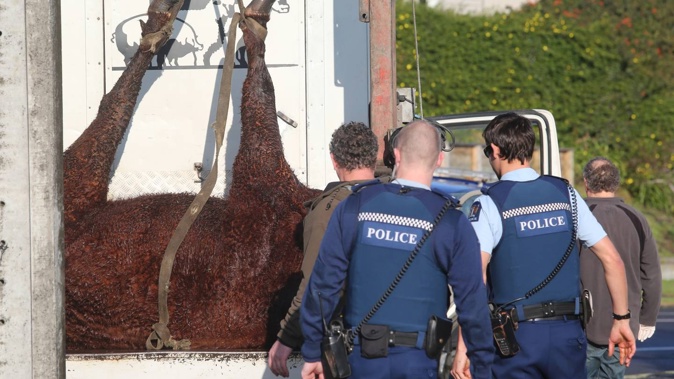
Police officers shot dead 62 animals last year, including cows, dogs, deer, sheep and a wallaby, according to newly released data.
Hundreds of rounds were fired at animals by police officers in the line of duty over the past four years, the Herald can reveal after data was released under the Official Information Act (OIA).
A total of 1024 shots were fired between 2018 and 2022, the police numbers show.
Cattle or cows came in the firing line most commonly, often when they have wandered on to public roads or highways and posed a high risk to motorists and the public.
In the 12 months from November 1, 2021, police officers shot dead 28 cattle or cows, with 79 shots fired.
In the same period, 10 dogs were killed, along with nine deer, seven sheep, two goats, two wild pigs (and one domesticated pig), an undisclosed “marine mammal”, one horse, a lone wallaby, and even a hare.
Two loose cattle caused havoc in Whanganui in July 2022, with one of the animals colliding with an officer. Photo / Bevan Conley.
The figures relate to the number of Animal Tactical Option Report (TOR) events, where police discharged a firearm, and the total shots discharged, separated by animal type.
Between 2018 and 2022, officers fired a total of 1024 shots at animals.
New Zealand Police say officers may be required to use force against an animal “if it is posing a risk to human life”, for example, animals loose on a highway.
“Other situations may include where an animal poses serious risk of injury or to life while staff are carrying out duties, for example, a dog attack,” a spokeswoman said.
“Police will take all reasonably practicable steps to eliminate or reduce the risk before the decision to destroy an animal [including stock] is made.”
Officers are also sometimes needed to euthanise animals if an animal control officer is not available, and the animal is suffering.
Remarkable photos taken by Whanganui Chronicle photographer Bevan Conley of a loose cow colliding with a police officer in central Whanganui made international headlines. Photo / Bevan Conley.
Police say that officers use the least amount of force required to safely resolve a situation in accordance with the Tactical Options Framework, which “ensures our response is proportionate to the situation presented to us”.
“Use of force continues to be rare and a small portion of the work our people do every day,” the police spokeswoman said.
“Tactical options support frontline police to prevent harm by enabling them to intervene effectively when an individual, or animal’s, behaviour puts either themselves or other people at risk of harm.”
Cows that find themselves on busy roads or highways can prove major dangers to the public. Photo / Bevan Conley.
Last year, dramatic photos emerged of a rampaging runaway cow knocking down a police officer in Whanganui.
Two cattle rampaged through the quiet suburb of Gonville before one of them charged an officer on the grounds of a New Zealand Army facility.
Police eventually managed to contain one of the cows, but the other animal was put down after it got stuck in mud.
And again in Whanganui’s Gonville, this time in 2015, a police officer took at least nine shots to kill a cow that was running through peak traffic.
Constable Luke Cranstone from Whanganui police said the cow, which appeared to be in calf, started running down Puriri St, charging at anything in its path.
“We got down to Kauri St and we tried to contain it in an empty section until animal control arrived, but it wasn’t interested in that,” he said at the time.
“It tried charging me a couple of times and I had to hit it with my baton. It nearly knocked me off my feet.”
The officer said the cow even “had a go” at a man in a wheelchair, who was crossing the road on a pedestrian crossing.
Fearing the cow was heading towards peak traffic, police shot it dead.
Take your Radio, Podcasts and Music with you

/cloudfront-ap-southeast-2.images.arcpublishing.com/nzme/6JPLY5FCKZHBPF7UZ2O66OJIIY.JPG)
/cloudfront-ap-southeast-2.images.arcpublishing.com/nzme/KLFYBQY4JZCW5MJI653YT7TPVM.JPG)
/cloudfront-ap-southeast-2.images.arcpublishing.com/nzme/OHMGH55PNNF6NMHYCDN46EJVLQ.JPG)








